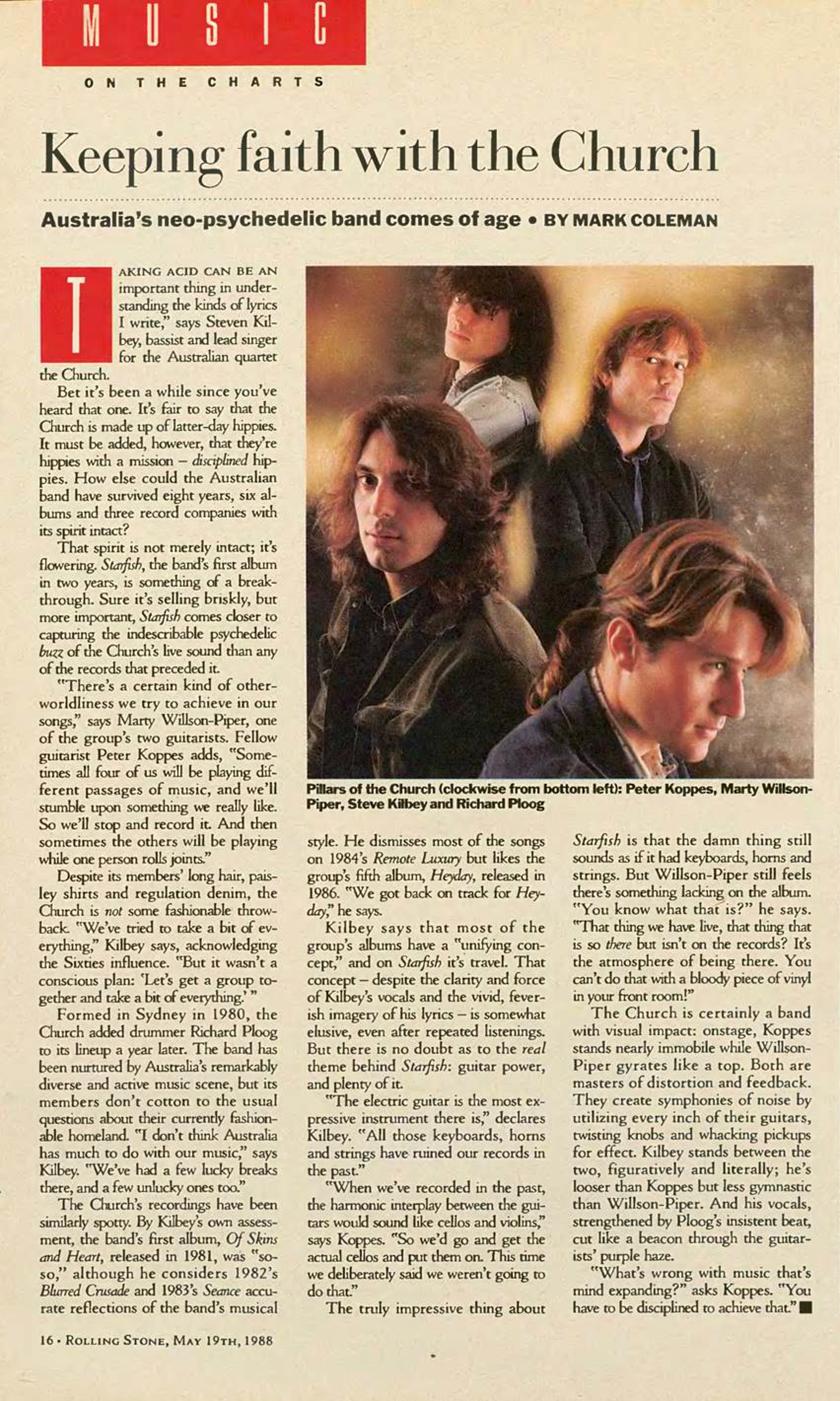
Rolling Stone - 19th May 1988


Rolling Stone - 19th May 1988

(transcription from the old Shadow Cabinet website)
***********************************************************
Source: Rolling Stone Magazine (New York, USA)
Issue: No.526
Date: May, 1988
Subject: Biography - The Church
***********************************************************
IN THIS ISSUE
THE CHURCH
BY MARK COLEMAN
With Starfish, these latter-day hippies from down under are on their
way to guitar heaven.
MUSIC
ON THE CHARTS
KEEPING FAITH WITH THE CHURCH
AUSTRALIA'S NEO-PSYCHEDELIC BAND COMES OF AGE
BY MARK COLEMAN
"Taking acid can be an important thing in understanding the kinds of
lyrics I write," says Steven Kilbey, bassist and lead singer for the
Australian quartet the Church.
Bet it's been a while since you've heard that one. It's fair to say
that the Church is made up of latter-day hippies. It must be added,
however, that they're hippies with a mission - disciplined hippies. How
else could the Australian band have survived eight years, six albums
and three record companies with its spirit intact?
That spirit is not merely intact; it's flowering. Starfish, the band's
first album in two years, is something of a break-through. Sure it's
selling briskly, but more important, Starfish comes closer to capturing
the indescribable psychedelic buzz of the Church's live sound than any
of the records that preceded it.
"There's a certain kind of otherworldliness we try to achieve in our
songs," says Marty Willson-Piper, one of the group's two guitarists.
Fellow guitarist Peter Koppes adds, "Sometimes all four of us will be
playing different passages of music, and we'll stumble upon something
we really like. So we'll stop and record it. And then sometimes the
others will be playing while one person rolls joints."
Despite its members' long hair, paisley shirts and regulation denim,
the Church is not some fashionable throwback. "We've tried to take a
bit of everything," Kilbey says, acknowledging the Sixties influence.
"But it wasn't a conscious plan: 'Let's get a group together and take a
bit of everything.'"
Formed in Sydney in 1980, the Church added drummer Richard Ploog to its
lineup a year later. The band has been nurtured by Australia's
remarkably diverse and active music scene, but its members don't cotton
to the usual questions about their currently fashionable homeland. "I
don't think Australia has much to do with our music," says Kilbey.
"We've had a few lucky breaks there, and a few unlucky ones too."
The Church's recordings have been similarly spotty. By Kilbey's own
assessment, the band's first album, Of Skins and Heart, released in
1981, was "so-so," although he considers 1982's Blurred Crusade and
1983's Seance accurate reflections of the band's musical style. He
dismisses most of the songs on 1984's Remote Luxury but likes the
group's fifth album, Heyday, released in 1986. "We got back on track
for Heyday," he says.
Kilbey says that most of the group's albums have a "unifying concept,"
and on Starfish it's travel. That concept - despite the clarity and
force of Kilbey's vocals and the vivid, feverish imagery of his lyrics
- is somewhat elusive, even after repeated listenings. But there is no
doubt as to the real theme behind Starfish: guitar power, and plenty of
it.
"The electric guitar is the most expressive instrument there is,"
declares Kilbey. "All those keyboards, horns and strings have ruined
our records in the past."
"When we've recorded in the past, the harmonic interplay between the
guitars would sound like cellos and violins," says Koppes "So we'd go
and get the actual cellos and put them on. This time we deliberately
said we weren't going to do that."
The truly impressive thing about Starfish is that the damn thing still
sounds as if it had keyboards, horns and strings. But Willson-Piper
still feels there's something lacking on the album. "You know what
that is?" he says. "That thing we have live, that thing that is so
there but isn't on the records? It's the atmosphere of being there.
You can't do that with a bloody piece of vinyl in your front room!"
The Church is certainly a band with visual impact: on-stage, Koppes
stands nearly immobile while Willson-Piper gyrates like a top. Both are
masters of distortion and feedback. They create symphonies of noise by
utilizing every inch of their guitars, twisting knobs and whacking
pickups for effect. Kilbey stands between the two, figuratively and
literally; he's looser than Koppes but less gymnastic than
Willson-Piper. And his vocals, strengthened by Ploog's insistent beat,
cut like a beacon through the guitarists purple haze.
"What's wrong with music that's mind expanding?" asks Koppes. "You have
to be disciplined to achieve that."
***END***
Return to 1988 index